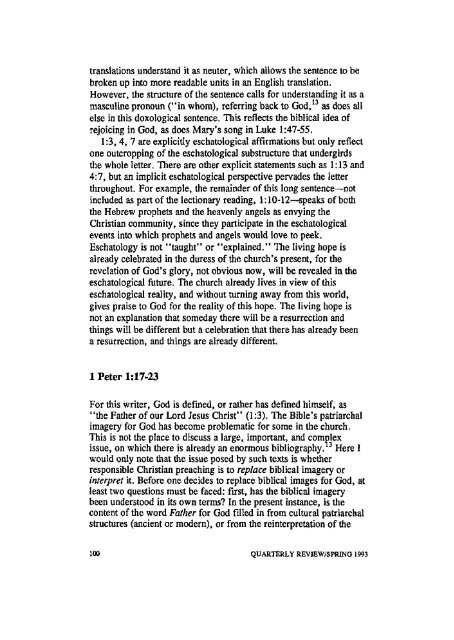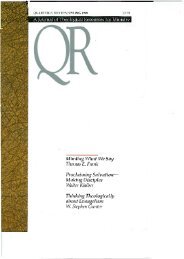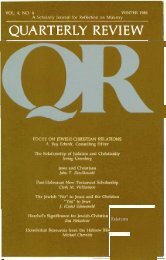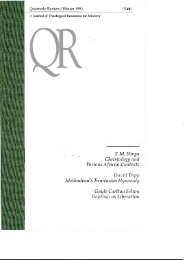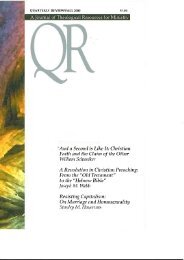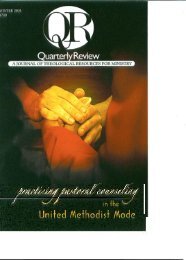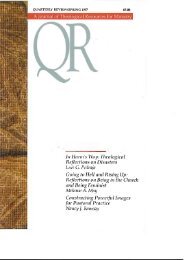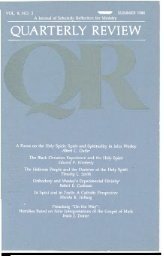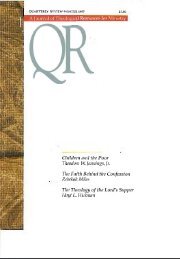TJieodore W. Jennings, Jr. The Meaning of ... - Quarterly Review
TJieodore W. Jennings, Jr. The Meaning of ... - Quarterly Review
TJieodore W. Jennings, Jr. The Meaning of ... - Quarterly Review
Create successful ePaper yourself
Turn your PDF publications into a flip-book with our unique Google optimized e-Paper software.
translations understand it as neuter, which allows the sentence to be<br />
broken up into more readable units in an English translation.<br />
However, the structure <strong>of</strong> the sentence calls for understanding it as a<br />
masculine pronoun ("in whom), referring back to God, 13<br />
as does all<br />
else in this doxological sentence. This reflects the biblical idea <strong>of</strong><br />
rejoicing in God, as does Mary's song in Luke 1:47-55.<br />
1:3,4, 7 are explicidy eschatological affirmations but only reflect<br />
one outcropping <strong>of</strong> the eschatological substructure that undergirds<br />
the whole letter. <strong>The</strong>re are other explicit statements such as 1:13 and<br />
4:7, but an implicit eschatological perspective pervades the letter<br />
throughout. For example, the remainder <strong>of</strong> this long sentence—not<br />
included as part <strong>of</strong> the lectionary reading, 1:10-12—speaks <strong>of</strong> both<br />
the Hebrew prophets and the heavenly angels as envying the<br />
Christian community, since they participate in the eschatological<br />
events into which prophets and angels would love to peek.<br />
Eschatology is not "taught" or "explained." <strong>The</strong> living hope is<br />
already celebrated in the duress <strong>of</strong> the church's present, for the<br />
revelation <strong>of</strong> God's glory, not obvious now, will be revealed in the<br />
eschatological future. <strong>The</strong> church already lives in view <strong>of</strong> this<br />
eschatological reality, and without turning away from this world,<br />
gives praise to God for the reality <strong>of</strong> this hope. <strong>The</strong> living hope is<br />
not an explanation that someday there will be a resurrection and<br />
things will be different but a celebration that there has already been<br />
a resurrection, and things are already different.<br />
1 Peter 1:17-23<br />
For this writer, God is defined, or rather has defined himself, as<br />
"the Father <strong>of</strong> our Lord Jesus Christ" (1:3). <strong>The</strong> Bible's patriarchal<br />
imagery for God has become problematic for some in the church.<br />
This is not the place to discuss a large, important, and complex<br />
issue, on which there is already an enormous bibliography. Here I<br />
would only note that the issue posed by such texts is whether<br />
responsible Christian preaching is to replace biblical imagery or<br />
interpret it. Before one decides to replace biblical images for God, at<br />
least two questions must be faced: first, has the biblical imagery<br />
been understood in its own terms? In the present instance, is the<br />
content <strong>of</strong> the word Father for God filled in from cultural patriarchal<br />
structures (ancient or modern), or from the reinterpretation <strong>of</strong> the<br />
100 QUARTERLY REVIEW/SPRING 1993


